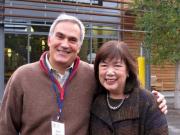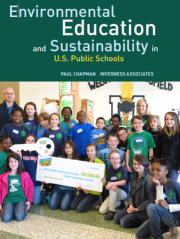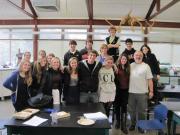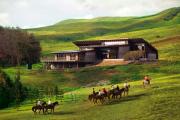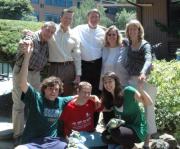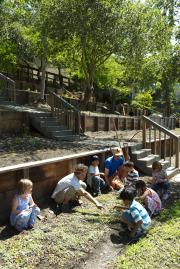Berkeley's Green Schools
This year gave me an opportunity to study the environmental sustainability initiatives that have made my home city of Berkeley a leader. In typical fashion for Berkeley, the schools are being greened from the ground up, though individual initiatives. As I discovered when I became the head of the Green Team at the First Congregational Church, the city's faith-based institutions are part of that effort. And the private schools are playing their part, including the East Bay School for Boys, which has found a new home at the Congregational Church.
1. Berkeley’s Green Schools: Bold Innovation
Berkeley California has long been known for embracing progressive causes, and it is no surprise that the city has gained international recognition for its significant and innovative commitment to environmental sustainability. The City of Berkeley itself has adopted a comprehensive sustainability plan with a “zero waste” goal and has pledged to reduce its carbon footprint 80% by 2050; the University of California Berkeley is acknowledged as a sustainability leader in higher education; and farmers markets, edible gardens and urban farms abound. In this urban hothouse of ideas and innovation, the Berkeley public schools are playing an important role in making the city greener.
Berkeley Unified School District (BUSD) has 16 schools serving 9,400 students, with 11 elementary, three middle, and one comprehensive high school and an alternative high school. The district has long recognized that equity and justice are critical elements in a successful school system; in 1968, BUSD was the nation’s first school district to desegregate without a court order. Students and staff in BUSD come from a wide variety of ethnic and socioeconomic backgrounds, and while the district overall is meeting California proficiency standards, there is a persistent “achievement gap.” This district has many innovative programs addressing health and sustainability issues, including its healthy lunch program, school gardens, and a variety of classroom environmental education programs and field trips, most often integrated with teaching science. The BUSD Facilities Department has invested in energy and water conservation measures. And BUSD benefits from the support and leadership of many active local non-profit organizations, including the Green Schools Initiative, the Center for Ecoliteracy, and KyotoUSA. The profiles that follow illustrate the variety of green initiatives that characterize the district’s commitment to environmental sustainability.
Founded in the late nineteenth century, Berkeley High School has grown to become the city’s only comprehensive public school that enrolls a student body of about 3,200 that is prized for its achievements, its diversity, and its alumni, who include notable artists, activists, authors, musicians, politicians and scientists. The school had participated in periodic educational reforms, as I recall from my own study of its alternative, school-within-a-school approach in the 1970s. Today the school consists of six smaller schools, or “learning communities,” including the Green Academy, which was founded initially to focus on social justice and ecological themes. For five years beginning in 2006, Kate Trimlett has been the lead teacher and a moving force in creating the Green Academy. Raised in a desert community near San Diego, she credits early experiences camping with her family and a high school trip to Costa Rica for her devotion to the environment. After receiving her B.A. from U.C. Davis in evolution and ecology, she developed her interest education through an Americorps internship and elementary school science teaching. Berkeley High School’s principal recruited her from the Stanford Teacher Education Program (STEP) to help lead the environmental program.
Berkeley High’s Green Academy mission is to “prepare students for college and green careers,” to “provide opportunities in science and mathematics,” and to “engage students in understanding and solving the problems that face humanity and our planet in the 21st century.” Students select one of two pathways: S.E.E.D. (Sustainability, Ecology, and Environmental Design) or H.E.A.T. (Human Energy and Appropriate Technology). Academy students engage in project-based learning at the high school and in the community that are integrated into the curriculum, including such areas as sustainable energy, habitat restoration, environmental literacy, green education, gardening, the impact of pollution, and waste reduction. Seniors participate in an internship to focus on real-world practices with local organizations like the David Brower Center, Stop Waste, and East Bay Green Tours. The curriculum offers students over a dozen AP courses from environmental science to physics, and according to the school they “will be prepared for college, be knowledgeable about social and environmental issues, and take personal responsibility for seeking change in themselves and in the world.”
Touring the campus recently, it was clear that the school has taken many steps to make its campus sustainable, in addition to the Green Academy curricular focus. With encouragement from Kate Trimlett and her students, the school now has an edible garden and a native plant garden. Nearby, the school’s cafeteria features local, seasonal food. Waste management containers for green waste, recycling, and trash are positioned in many locations in the cafeteria and classrooms. Bike racks are plentiful and full, and many students use public transport to and from school. The athletic field has been retrofitted with artificial turf to save water. Many of the buildings were constructed in the 1930s art deco style, and with the regular on-shore breezes are naturally ventilated. Construction is underway on a new building that will house classrooms and a gym, all of which officials hope will be LEED certified. Berkeley High’s Student Leadership program added a position of Commissioner of Environmental Sustainability two years ago, and students work to engage their Berkeley High peers in sustainability practices, like recycling and composting, beyond the Green Academy students.
Given these impressive accomplishments, it was difficult to learn that the Green Academy will transition from a California Partnership Academy into a different program over the next three years, principally due to low enrollments this year that may have resulted from changes to the sign-up procedures. The Green Academy future suggests how fragile environmental sustainability efforts can be in times of unsettled school budgets and enrollment.
Elsewhere in Berkeley, other examples of innovative approaches to environmental education are everywhere apparent. In 1995 at Martin Luther King Jr. Middle School, chef Alice Waters of the world-renowned Chez Panisse began the Edible Schoolyard Project by developing a one-acre plot into a teaching garden integrated with a kitchen and cooking curriculum. Almost a decade later, the Berkeley’s Center for Ecoliteracy partnered with the ESY project to launch the Rethinking School Lunch initiative. Berkeley Unified School District revolutionized the way food is sourced, prepared and presented to students when they hired Ann Cooper, the self-styled “renegade lunch lady” who is now director of food services for the Boulder, Colorado schools. King’s garden and BUSD’s lunch program are models that have been replicated far and wide. From the seeds Alice Waters planted nearly two decades ago in Berkeley - that students require nutritious food in school and that they will eat nutritious food once they’ve grown it themselves in a school garden - a movement a healthy school lunch program is sweeping the country.
Another key partner in transforming Berkeley’s public schools is the Green Schools Initiative, co-founded by Deborah Moore in 2004. A physicist by training, she spent many years as a senior scientist with the Environmental Defense Fund. When her daughter enrolled at the Prospect Sierra School north of Berkeley, she was amazed that recycling had yet to be embraced. She organized a group of students to design the system and a group of parents and teachers to help, and from that effort came the non-profit she heads that supports schools across California and around the country in their efforts to go green. Several years ago, the Green Schools Initiative partnered with Rosa Parks Elementary School in Berkeley to incorporate environmental sustainability in the curriculum as a complement to the nature and play based green schoolyard. And this year GSI is helping lead the establishment and training of Green Teams that will promote zero waste and sustainability behaviors at eight BUSD schools, including Berkeley High, King Middle School, and 6 elementary schools. “Berkeley Unified has been a pioneer in many green school efforts, especially around school gardens and food, but we can’t rest on our laurels,” says GSI’s Deborah Moore. “There are still many ways that Berkeley schools can deepen its efforts in reducing waste, energy, and water, switching to green cleaners, saving money, and engaging students. The district can capitalize on the innovative leaders in our community and at Cal to take its efforts to the next level!”
The commitment to green schools runs deep in Deborah Moore’s family. Her daughter, Mariah is a senior at Berkeley High School and is this year’s Commissioner of Environmental Sustainability! As she told me recently, “I think it is crucial that people everywhere start focusing their energy on the environment. The earth is our home and there are so many small things we can do that if everyone does them will make such huge changes. I'm just doing my part because I feel like if a school as big as Berkeley High made some little changes it could actually make a difference.”
While Berkeley schools are having success individually in growing greener, the district is working to adopt system-wide practices that will effect more improvements. A notable example is the KyotoUSA project headed by Berkeley resident Tom Kelly. Frustrated by the failure of the U.S. Congress to approve the 1999 Kyoto Protocol, he helped launch an effort for cities to make their own commitments to reduce their carbon footprint, with Berkeley making its pledge in 2005. Since then KyotoUSA has developed the Helios Project, beginning with Washington Elementary School, the first Berkeley school to be “powered by the sun.” The Helios Project has created solar master plans for three public school districts, including Berkeley, and hopes to bring the initiative to all of California’s 1,000 public school districts. These master plans show how districts can integrate solar installations into their regular facilities infrastructure investments in ways that make going solar easy and affordable.
Berkeley’s culture prizes individual initiative and democratic approaches to change. With an even more concerted commitment from those in charge of the district’s programs and policies, Berkeley’s schools can become a model for how to “grow green.”
2. A Green Partnership Based on Faith: The First Congregational Church of Berkeley and the East Bay School for Boys
In the spring of 2012 I made an appointment to see Pat de Jong, the Senior Minister of the First Congregational Church of Berkeley, where I have been a member for 25 years. Pat de Jong has been a remarkably strong pastor, a brilliant preacher, passionate on matters of social justice, and a colleague of the renowned William Sloan Coffin at the Riverside Church in New York. I told her of my interest in helping FCCB become more environmentally sustainable. “That’s terrific,” she said, “I have half a dozen projects I would like to start immediately!” So began the effort to green our church, along with the new East Bay School for Boys, which was scheduled to move into renovated facilities on our campus in September.
When I first became involved in greening Head-Royce School in Oakland in 2006, I sought the advice of Berkeley’s Center for Ecoliteracy. They explained that any such systemic effort had to be based on the principles of ecological literacy, and they helped shape our green mission that “education for sustainability requires, in addition to environmental knowledge, the acquisition of particular skills, values, and vision needed to put that knowledge into practice. Education for sustainable living cultivates competencies of head, heart, hands, and spirit….” It was this last value, the “spirit,” that seemed especially appropriate for the church, to develop a “sense of wonder, capacity for reverence, deep appreciation of place, a feeling of kinship with the natural world, and the ability to invoke that feeling in others.”
Soon after my meeting with Pat de Jong, we moved to create a new Green Ministry Team, which in the church is the way volunteers can identify an issue and come together to work on it. Not wanting to re-invent the wheel, we discovered ample resources to shape the process, especially those from Earth Ministry in Washington State and their Greening Congregations Handbook. We decided to focus on six broad areas: mission, worship, education, institutional life, community connections and denominational outreach. It was clear our work benefited from several decades of environmental efforts at the church, beginning in the 1980s and the establishment of a Sunday farmer’s market and thrift shop for reused materials and more recently with the Climate Action Team around 2006 that urged members of the congregation take personal steps to address the issue of global warming. We also learned that the Interfaith Power and Light, and its Regeneration Project, had the resources we needed to accomplish our task.
We adopted a simple mission: “To promote environmental stewardship so that we may respect, enjoy and preserve God’s gift of life on Earth.” Further, we declared our desire to “increase awareness and knowledge of environmental challenges as they relate to the world’s growing population, widespread poverty, ecological decline, and our changing climate. We wish to encourage environmentally sustainable practices, through efficient use of resources, a healthy environment, ecological education, nutritious food, and environmental justice, in our church, in our daily lives, in our local community, and around the globe. We pledge to do our part to advocate for sustainable community practices.”
The initial impact of our efforts has been heartwarming. The senior ministers have declared a year’s theme of “caring for each other, caring for the earth,” and their sermons have been devoted to exploring why becoming more sustainable is such a vital priority for all of us. The adult education committee has decided to sponsor speakers and forums on environmental topics this coming year, and a team is evaluating the Church School curriculum to incorporate environmental education topics. Another group is examining our physical plant and making improvements. We have upgraded our recycling program by adding green waste pick up, plan to have a waste audit, are preparing our carbon calculator, and promoting transportation efficiency through carpools, public transport, and bicycling. Our building committee has conducted an energy audit, and is renovating the facility for the new school using green standards. Our community outreach efforts have always been strong, and we are identifying new projects to take on, like regular beach cleanups. The United Church of Christ ministry is planning a Mission 4/1 Earth for spring 2013 so our efforts can become part of a larger initiative over the 50 days from Easter to Pentacost.
Quite serendipitously, the church decided last year to repurpose a portion of the campus and invite a partner, the new East Bay School for Boys, to move from another location in Berkeley. Founded three years ago, the EBSB is an outgrowth of the very successful Julia Morgan School for Girls, a 6-8 middle school on the Mills College campus begun a decade ago. School head Jason Baeten is very committed to making sure his school is environmentally sustainable. Raised in Wisconsin in a large family near Green Bay, his father was a biology professor who brought up his nine children on a farm with goats, horses, and chickens. During his years on the family farm, and later while teaching at The Prairie School and while getting a masters degree from Middlebury College, he shaped his commitment to environmental education. At EBSB, the boys are quickly introduced to the idea of “less is more” when they build their own school desks and are assigned responsibility for all the recycling, composting and trash processing. A strong outdoor education program introduces them to camping in the nearby Sunol Wilderness, Pt. Reyes National Seashore, and in eighth grade the nation’s natural beauty on a cross-country bus trip to Washington DC.
The partnership between the First Congregational Church of Berkeley and the East Bay School for Boys is just beginning. We have made plans for the students to join our Green Team and assist in our efforts to improve the Church’s energy efficiency. This emerging partnership is model for how faith communities and schools can collaborate to strengthen each institution, and adopt practices that are good for the Earth as they do.


